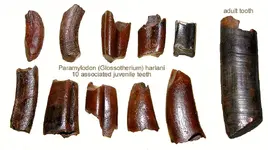huntress104 said:
ok I have to ask, how do you know it's a sloth tooth?
I'm glad you asked. Sloth teeth are fairly common fossils. There are three giant (and one smaller) sloths known from the Pleistocene deposits in Florida. The three are fairly easily distinguished from one another.
As for the characteristics of sloth teeth: "The dentition in xenarthrans is typically reduced in tooth types and numbers and all lack enamel. There is no milk dentition, and the teeth are ever-growing. No xenarthran has identifiable incisors.
"Sloths are the only xenarthrans with canine-shaped teeth, and in these animals they occlude upper in front of lower, opposite from the pattern in other mammals, making their relationships to true canine teeth uncertain. Therefore, in sloths those teeth are called 'caniniform.'
"Likewise, neither premolars nor molars can be distinguished in sloths, armadillos or glyptodonts, and the cheek teeth are all similar in appearance and all called "molariform." The anteaters are the only edentulous xenarthrans, although the group was previously known as the Edentata.
"The teeth in sloths erupt as simple cones, and acquire the cusp pattern characteristic of each species through wear caused by movements of the masticatory muscles. The generation of tooth wear patterns in other xenarthrans has not been studied." [from novelguide.com]

